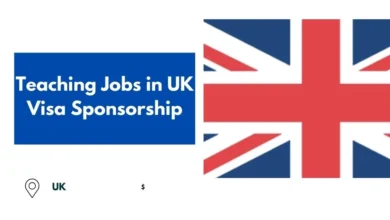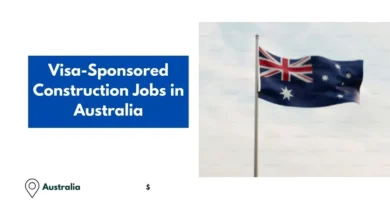Australia Work Visa Process 2024 – Apply Now
As part of the Government Budget, the Australian Government has recently disclosed several significant modifications to the movement framework. One significant change is the reduction of the work experience requirement for obtaining a Subclass 482 Brief Abilities Deficiency (TSS) visa. This change is expected to take effect in late, subject to parliamentary approval.
Candidates for the TSS 482 visa will be required to demonstrate one year of full-time work experience in their occupation or a related field, as opposed to the previous requirement of two years, beginning on November 23, 2024, provided that the modifications are approved by parliament.
It is crucial to acknowledge that additional work experience will be necessary if a candidate lacks the fundamental capabilities. Additionally, the level of proficiency, the recentness of the work experience, and the type of capability held will all influence the level of satisfaction with the work involvement.
Check Also: Kitchen Helper Jobs in Australia – Visa Sponsorship
Types of Australia Work Visa Process
While there are numerous types of Australian work visas available, the most frequently used work visas are as follows:
- Subclass 858 of the Global Ability Visa. Two pathways are available for a global talent visa, contingent upon your talents. In order to participate in the streamlined pathway, you will be required to submit an expression of interest. A permanent worldwide ability visa allows you to reside in Australia indefinitely.
- Employer Designation Conspire Visa-subclass 186. If you possess support, you may be eligible to apply for a constant work visa, such as the 186 visa. You will be able to choose from one of the streams that are available for an 186 visa:
- A stream with a coordinate section.
- A stream of activity that facilitates comprehension.
- A brief home movie transmission.
- Permanent Gifted Territorial Visa-subclass 191. No changes were made to the original sentence. This is frequently a long-term work visa; however, in order to file for subclass 191, it is necessary to have held a substantial visa in the past.
- Subclass 187 of the Regional Sponsored Movement Visa. If you have previously held a substantial work visa and have been employed by the same manager during that time, you are eligible to petition for an 187 visa.
- The Regional Visa-subclass 494 was supported by a skilled manager. You may be permitted to work in specific areas that your supporting employer has assigned you with a 494 visa. This visa is valid for five years and is temporary. If you are eligible, you will be able to petition for permanent residency after three years.
- Subclass 189: Skilled Free Visa. Visa 189 is a points-based visa, requiring a minimum of 65 points from the abilities table to qualify. If you are granted an 189 visa, you will be permitted to remain in Australia indefinitely.
- Subclass 190 of the Skilled Designated Visa. Visa 190 is a work visa that is perpetual and can be obtained without any difficulty if you are eligible to apply. If you satisfy the focus qualification criteria, you may receive a welcome.
- Subclass 476 of the Skilled Recognized Graduate Visa. Visa 476 is granted to late-stage graduates in Australia who exhibit exceptional capabilities in their respective fields. In any event, this visa is temporary, lasting for a period of 18 months.
- Subclass 887 of the Skilled Territorial Visa. If you possess a short-term work visa, you may be eligible to apply for Visa 887, which is a permanent visa.
- Skilled Territorial (Temporary) Visa—subclass 489. If you possess a territorial visa that has been gifted to you, you will submit an application for a 489 visa. Although Visa 489 is brief, you will be required to apply for a changeless visa after a significant period of time.
- Skilled Work Regional Visa-subclass 491. Individuals who are exceptionally qualified and educated are granted a 491 visa. You are seeking to satisfy the key requirements for a visa 491 and submit an expression of interest. You are eligible to apply for permanent residency after three years of holding a 491 visa.
- Temporary Action Visa—subclass 408. During the pandemic, Visa 408 may be issued as a temporary visa to facilitate the extension of visitors’ existing visas. If you can demonstrate that the global pandemic has had an impact on you, you will be eligible to apply for visa 408.
- Temporary Graduate Visa- subclass 485. According to your vocation, you may choose from two streams when applying for a 485 visa. For instance, in order to be eligible for the graduate work stream, your occupation must be included in the list of abilities. Visa 485 is temporary and considerable for a period of two to four years, regardless of the stream you select. The only way to secure a permanent visa is to submit an application for another work visa.
- Temporary Work Universal Relations Visa—subclass 403. Each of the six segments of this visa has its own set of prerequisites and specifics. Depending on which stream you satisfy the qualification criteria for, you may submit an application for this visa.
- Temporary Work Visa for Brief Remain Master-subclass 400. If you possess a specialized skill that is in short supply in Australia, you will be eligible to apply for this visa. Typically, this visa is granted for a period of three months; however, in a few instances, it may be extended to six months.
- Deficiency Visa for Temporary Expertise – subclass 482. Three accessible streams are available for the Visa 482 application, depending on which one is more suitable for you. In order to obtain this visa, you must be sponsored and assigned by your supervisor. This visa is temporary; however, you may petition for permanent residency after a period of time.
Requirements for Australia Work Visa Process
The qualifications for unique work licenses in Australia are contingent upon the specific visa category. The requirements for a permanent worker visa in Australia include relevant skill sets, age restrictions, and assessment remuneration.
- Under the age of 45
- Ensure that the wellbeing requirements are met
- Satisfy the character requirements
- Adequate proficiency in the English language
- Three years of work experience and relevant aptitudes
- The Australian values statement must be signed.
- The booklet “Life in Australia” has been read or has been clarified.
- It is preferred that there be no prior visa cancellations.
Benefits of Australia Work Visa Process
- Permanent Residency (PR) Pathway: Numerous work visas, including the Skilled Independent Visa (subclass 189) and Employer Nomination Scheme (subclass 186), provide pathways to permanent residency. This enables individuals and their families to reside, work, and study in Australia indefinitely, with the potential to obtain citizenship.
- High Demand for Skilled Professionals: Australia’s skilled migration program prioritizes professions in demand, which increases the likelihood of visa approval for applicants with specific qualifications and skills. This is due to the high demand for skilled professionals. Better job opportunities and financial stability are frequently the result of skilled work visas.
- Opportunity to Bring Family Members: The majority of Australian work visas permit the entry of intimate family members, including spouses, partners, and dependent children, to reside, work, or study in Australia. This facilitates the relocation of loved ones.
- Access to Quality Healthcare: Medicare, Australia’s public healthcare system, is accessible through numerous work visas. Australia’s comprehensive healthcare services are accessible to individuals through permanent residency and certain temporary visas, which significantly reduces medical expenses.
- High Quality of Life: Australia is renowned for its exceptional quality of life, which is characterized by a harmonious combination of work and leisure, exceptional healthcare, and robust social services. Cities in Australia consistently achieve high rankings in global livability indexes, ensuring that work visa holders are provided with a secure, clean, and healthy environment.
- Work Rights and Protections: Australia’s labor laws include robust protections for workers, such as a minimum wage, safe working conditions, and anti-discrimination provisions. These regulations ensure that visa holders receive equitable treatment in the workplace.
- World-Class Education for Children: Public education is available to dependents on numerous work visas, and it is either free or inexpensive at the primary and secondary levels. Australia’s education system is highly regarded, offering children the opportunity to excel academically and receive a high-quality education.
- Professional Development Opportunities: Working in Australia provides the opportunity to gain exposure to a variety of industries and innovative practices, which can substantially improve your professional skills and experience. Many industries offer training and development opportunities that facilitate career advancement.
- Regional Incentives Eligibility: Australia provides incentives to migrants who opt to reside and operate in regional regions. Applicants who are willing to work outside of main metropolitan areas are granted additional points or benefits by certain visas, such as the Skilled Work Regional Visa (subclass 491). This can also increase the likelihood of obtaining permanent residency.
- Social Security and Welfare Benefits: Upon obtaining permanent residency, visa holders are eligible for social welfare benefits, including unemployment assistance, family tax benefits, and pensions, which provide a financial safety net for themselves and their families.
Documents Required
A list of archives that are necessary for work permitted in Australia is as follows:
- Valid Passport
- Australian Visa Application form
- Identity photo
- National Personality Card
- Education Certificates
- Evidence of Monetary Statements
- Proof of Great Character/Police Certificate
- Company’s Arrangement Letter
- Sponsorship Letter (in case of Supported Work)
- Visa Installment Receipt
- Employer Letter
- Invitation Letter
Australia Work Allow Application Process
There are several stages that must be meticulously followed in the application process to obtain work authorization in Australia. Obtaining the desired visa is the most critical component of the Australian work visa application procedure. Employers must similarly determine the visa category into which their representatives would be classified. Ensure that you are. The online assignment was recently completed; your employee is currently in the process of applying for an Australian work permit.
The process for obtaining a work visa in Australia as an employee is as follows:
- Visit the official website of the Australian Government Office of Domestic Undertakings at https://immi.homeaffairs.gov.au). If you are applying for a working holiday visa, it is important to note that it allows individuals between the ages of 18 and 30 (or 35 for certain countries) to secure an extended stay in Australia while also being permitted to work to support their travels.
- Choose the type of visa for which you are applying and complete the form.
- Verify that your occupation is included in the list of gifted occupations for Talented Visas.
- To obtain a Supported Visa, obtain an assignment from a recognized employment support organization and subsequently proceed with the abilities assessment.
- Submit an Expression of Expectation (EOI) via SkillSelect.
- To apply for a visa, please wait for a welcome.
- Collect your documentation.
- Submit the visa application within 60 days of receiving the invitation.
- Please submit the online visa application.
Time Duration
The preparation period for a variety of work grants can vary significantly based on the visa category:
- Despite the fact that subsequent efforts in 2024 have focused on reducing the preparation time for candidates in fundamental sectors, the Talented Work Visa (subclass 189/190) typically requires 12 to 18 months.
- The processing time for business proprietor visas may exceed 24 months.
- Temporary work visas are typically processed within one to three months and have a significantly reduced time frame.
- The processing periods for territorial visas, such as the Gifted Work Territorial (491), have been reduced to encourage the relocation of talented individuals to territorial regions.
Frequently Asked Questions:
How do I get an Australia work visa?
Relevant Skills: You must possess the required skills and be nominated for the specified occupation. English language proficiency: demonstrated through an IELTS score or equivalent. Health and Character Assessment: Must pass both health and character checks.
How long does it take to get a working visa for Australia?
Most applications are processed within 14 days, but it can take longer if you don’t fill out the online form correctly or forget to attach the right documents. Once your visa has been granted, you have 12 months to fly to Australia and begin using it.
Is IELTS required for an Australian work visa?
To obtain a visa for Australian permanent residency, you can take either the IELTS Academic or IELTS General Training. However, you need IELTS Academic for professional registration and work in Australia.



